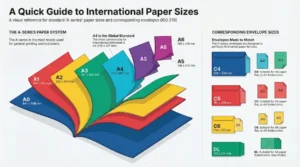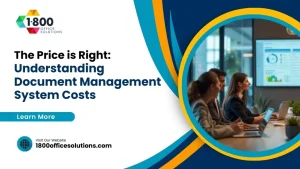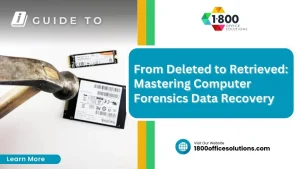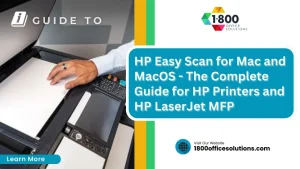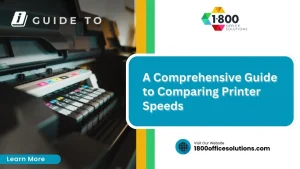Managed Print Services by 1-800 Office Solutions: Cut Printing Costs
Many businesses are surprised to discover that their printing costs can consume a significant portion of their budget. With the rise of data breaches and inefficient resource management, managing print expenses has never been more critical. This guide on Managed Print Services (MPS) will explore the key steps for evaluating your current printing expenses, implementing effective strategies to maximize savings, and optimizing your print infrastructure for better uptime and reduced consumption. By understanding these points, readers will learn how MPS can help solve the common problem of high printing costs, ultimately enhancing their bottom line.
Understanding Managed Print Services and Cost Savings

Managed Print Services (MPS) streamline printing processes, leading to significant cost savings. Traditional printing methods often incur high ownership expenses and environmental costs, including recycling challenges. MPS improves workflow efficiency while offering cost-saving components, such as optimized resource usage. The long-term financial benefits make MPS a vital consideration for businesses, enhancing budget management and sustainability.
Defining Managed Print Services
Managed Print Services (MPS) refers to the comprehensive management of a business’s print fleet, which includes printers, copiers, and multifunction devices. This service not only streamlines print management but also enhances customer service by allowing businesses to monitor and optimize their inventory and usage effectively. By using MPS, companies can reduce their printing costs, improve invoice tracking, and ultimately achieve better control over their printing environment, leading to significant long-term savings.
Financial Impact of Traditional Printing Methods
Traditional printing methods often lead to high operational costs, primarily through excessive energy consumption and the continuous need for toner replenishment. Businesses relying on outdated printing technology also face increased vulnerabilities in network security, as older devices may lack adequate protective features. Furthermore, engaging multiple vendors for printing needs can complicate management and inflate costs, making it difficult for organizations to streamline their expenses and embrace the benefits of digital transformation.
Cost-Saving Components of MPS
The cost-saving components of Managed Print Services (MPS) play a crucial role in reducing expenses for businesses. By providing enhanced visibility into printing assets, MPS allows organizations to identify wasteful practices and optimize resource usage. Transitioning towards a paperless office further maximizes savings by minimizing the need for physical materials, ultimately benefiting both financial performance and environmental sustainability.
Long-Term Benefits for Your Budget
Implementing Managed Print Services (MPS) can significantly reduce vulnerability to operational risks by streamlining print processes and enhancing efficiency. Organizations benefit from minimized downtime due to quicker resolutions of print job issues, which ensures continuous productivity. Additionally, establishing a clear printing policy increases accountability and enables better budget management, ultimately leading to substantial long-term financial savings.

Evaluating Your Current Printing Expenses
Businesses must assess their currentprinting expenses to uncover hidden costs associated with traditional printing methods. This evaluation involves identifying inefficiencies in equipment performance, analyzing the usage and waste of supplies, and calculating the total cost of ownership. Utilizing managed print services can enhance fleet management efficiency while promoting sustainability through better resource utilization and energy savings in line with Energy Star standards.
Identifying Hidden Costs in Printing
Identifying hidden costs in printing is essential for businesses seeking to optimize their print fleet. Many organizations overlook factors such as supply chain inefficiencies and the terms of their print contracts, which can significantly inflate overall printing expenses. For example, consider the costs associated with managing a larger print footprint; extra devices increase maintenance and supply demands, impacting the overall price of operation. By closely analyzing these elements, businesses can pinpoint areas of waste and streamline their processes, leading to substantial savings and a more efficient printing environment.
Assessing Equipment Efficiency
Assessing equipment efficiency is critical for businesses aiming to manage printing expenses effectively. By analyzing the performance of printers and copiers, organizations can identify underutilized devices and reduce their carbon footprint. This not only enhances accessibility for users but also streamlines accounting by minimizing the need for excessive help desk support due to faulty equipment. Making informed decisions about printer placement and usage can lead to significant cost savings and a more sustainable printing environment.
Analyzing Supply Usage and Waste
Analyzing supply usage and waste is crucial for any organization looking to optimize its print services. By monitoring the consumption of printing supplies, businesses can identify patterns and areas of excess that often contribute to inflated costs. Implementing a document management system can facilitate this process, allowing for more precise tracking and troubleshooting, ultimately leading to improved infrastructure efficiency and substantial savings.
Calculating Total Cost of Ownership
Calculating the total cost of ownership (TCO) for a print fleet is vital for businesses looking to implement managed print solutions effectively. This assessment includes not only the direct costs of equipment acquisition but also the indirect expenses like maintenance, supply usage, and potential data loss associated with inefficient practices. Additionally, evaluating factors such as scalability and the security features of managed print systems, including authentication protocols, can guide organizations toward more sustainable and cost-efficient printing strategies.
Implementing MPS to Maximize Savings

Implementing Managed Print Services (MPS) can greatly enhance productivity while minimizing risk. This section will cover essential steps for maximizing savings, including selecting the right MPS provider and planning the transition process. Customizing services to fit a business’s specific needs and providing adequate staff training will ensure effective use and optimal performance of printing resources.
Selecting the Right MPS Provider
Selecting the right managed print provider is crucial for maximizing savings and enhancing print security within an organization. Businesses should look for a provider that offers comprehensive support contact options, ensuring timely assistance for any issues that arise. Additionally, effective automation of processes, along with a reliable toner cartridge supply, can streamline operations, ultimately leading to reduced costs and improved efficiency.
Planning the Transition Process
Planning the transition process to Managed Print Services (MPS) is essential for maximizing savings and efficiency. Organizations must strategically focus on procurement strategies that streamline device management, ensuring that the right machines are selected based on usage requirements. A well-structured transition plan addresses existing document workflows and promotes carbon reduction by optimizing printing practices, leading to a more sustainable and cost-effective printing environment.
Customizing Services to Fit Your Needs
Customizing services to fit specific business needs is a crucial aspect of implementing Managed Print Services (MPS) effectively. By partnering with a provider like 1800 Office Solutions, businesses can tailor their print management strategies to address unique operational challenges, optimize resource allocation, and enhance overall efficiency. For example, assessing the types of documents frequently printed allows organizations to adjust their fleet composition, ensuring that the right devices are in place to support their workflow while minimizing unnecessary costs.
Training Staff for Effective Use
Training staff for effective use of Managed Print Services (MPS) is essential for maximizing savings and enhancing overall efficiency. By equipping employees with the knowledge to utilize print resources appropriately, organizations can significantly reduce unnecessary printing and resource waste. Practical training sessions can focus on best practices, such as proper document management and selection of optimal printing devices based on specific task requirements, leading to a more streamlined print environment and substantial cost reductions.

Optimizing Print Infrastructure for Cost Efficiency
Standardizing equipment and supplies is a crucial step in optimizing print infrastructure for cost efficiency. Utilizing energy-efficient devices can further enhance savings while streamlining document workflows reduces process delays. Additionally, implementing strategies to reduce unnecessary printing is essential to maximizing the benefits of Managed Print Services (MPS). Together, these practices contribute to significant financial and operational improvements.
Standardizing Equipment and Supplies
Standardizing equipment and supplies is a key strategy for optimizing print infrastructure and achieving cost efficiency through Managed Print Services (MPS). By reducing the variety of devices in use, businesses can streamline maintenance processes and simplify supply procurement, leading to lower overall expenses. For instance, using a consistent brand of printers and copiers across the organization not only enhances compatibility but also ensures more predictable supply needs, making budgeting easier and reducing waste.
Utilizing Energy-Efficient Devices
Utilizing energy-efficient devices is a crucial strategy in optimizing print infrastructure for cost efficiency. These devices not only reduce energy consumption but also lower operational costs significantly, leading to long-term savings for businesses. For example, employing printers that meet Energy Star standards can help organizations decrease their electricity bills while enhancing productivity by minimizing environmental impact, thus aligning operational goals with sustainability initiatives.
Streamlining Document Workflow
Streamlining document workflow is essential for maximizing cost efficiency when implementing Managed Print Services (MPS). By optimizing how documents are processed and shared, businesses can drastically reduce unnecessary printing and enhance productivity. For instance, utilizing digital document management systems can help organizations track and manage files efficiently, minimizing delays and waste while improving access to vital information, ultimately leading to significant savings.
Reducing Unnecessary Printing
Reducing unnecessary printing is a vital aspect of optimizing print infrastructure for cost efficiency under Managed Print Services (MPS). Businesses can implement policies that encourage digital document sharing and discourage excessive hard copies, significantly lowering supply costs and minimizing waste. By utilizing tools such as print tracking software, organizations can monitor printing habits and identify areas where printing can be reduced, leading to both financial savings and better environmental outcomes.
Monitoring and Managing Ongoing Costs

Setting up usage tracking systems is essential for monitoring and managing ongoing costs related to Managed Print Services (MPS). Analyzing data collected from these systems facilitates continuous improvement by identifying trends and usage patterns. Adjusting strategies based on these insights allows organizations to refine their print processes. Furthermore, reporting savings and performance metrics provides clear visibility into the financial benefits of MPS, ensuring businesses can maximize their investment effectively.
Setting Up Usage Tracking Systems
Setting up usage tracking systems is essential for effectively monitoring ongoing costs related to Managed Print Services (MPS). These systems provide businesses with valuable insights into printing habits, allowing for the identification of patterns that contribute to unnecessary expenditures. By implementing these tracking mechanisms, organizations can optimize their print strategies, fostering a culture of cost efficiency and minimizing waste across the print environment.
Analyzing Data for Continuous Improvement
Analyzing data collected from Managed Print Services (MPS) is critical for driving continuous improvement in printing practices. By examining usage metrics and cost trends, businesses can identify inefficiencies and make informed decisions to optimize their print environment. For instance, if a particular printer consistently shows high supply usage compared to others, organizations can investigate whether it is being overutilized or if it’s not the best fit for the tasks assigned to it, allowing for adjustments that lead to long-term savings.
Adjusting Strategies Based on Insights
Adjusting strategies based on insights gained from usage tracking systems is essential for optimizing the cost efficiency of Managed Print Services (MPS). By analyzing data on printing habits and supply utilization, businesses can identify which devices are underperforming or overused, allowing them to reallocate resources effectively. For instance, if a specific printer is consistently consuming excessive supplies, organizations can reassess its placement or usage policies to reduce costs and enhance productivity.
Reporting Savings and Performance Metrics
Reporting savings and performance metrics is critical for businesses utilizing Managed Print Services (MPS). Regular analysis of printing costs and efficiency allows organizations to identify areas of improvement and track the financial impact of implemented strategies. For instance, by comparing monthly print expenditures before and after MPS integration, companies can quantify their savings and demonstrate the value of optimized print management, aiding in informed decision-making for future resource allocation.
Real-Life Examples of Cost Reduction With MPS

This section examines real-life examples of cost reduction achieved through Managed Print Services (MPS). The case study of a small business showcases significant savings, while enterprise-level organizations illustrate effective cost optimization strategies. Additionally, industry-specific success stories highlight tailored implementations. Key lessons learned from MPS implementation will provide valuable insights for businesses seeking to maximize their savings potential.
Case Study: Small Business Savings
A small marketing agency recently implemented Managed Print Services (MPS) and experienced significant cost savings. By consolidating their printing devices and utilizing an optimized fleet, they reduced their printing expenses by over 30% within the first year. The agency also benefited from enhanced workflow efficiency, allowing them to focus more resources on creative tasks rather than print management, showcasing how MPS can transform printing operations for small businesses.
Enterprise-Level Cost Optimization
Enterprise-level organizations that implement Managed Print Services (MPS) have reported substantial cost optimizations by consolidating their print operations and enhancing resource management. For instance, a large financial institution streamlined its print fleet, resulting in a 25% reduction in overall printing costs while simultaneously improving document security. By optimizing printer usage and integrating advanced tracking systems, these enterprises not only achieve significant savings but also enhance their operational efficiency and accountability in managing print resources.
Industry-Specific Success Stories
In the healthcare sector, a mid-sized hospital adopted Managed Print Services (MPS) and saw a 40% reduction in printing costs within six months. By streamlining their printing processes and consolidating devices, they minimized waste and improved document security, which is critical in handling sensitive patient information. This strategic approach not only led to significant cost savings but also enhanced operational efficiency, demonstrating how MPS can meet the unique demands of the healthcare industry.
Lessons Learned From MPS Implementation
Businesses that have implemented Managed Print Services (MPS) often discover key lessons that can enhance their print management strategies. One significant insight is the importance of regular monitoring and adjustments based on usage data, which helps organizations maintain cost efficiency and reduce waste. Additionally, fostering a culture that encourages sustainable printing behaviors among staff can lead to higher compliance rates and more effective utilization of resources, ultimately supporting the overall goal of maximizing savings through MPS.
Streamlining Workflow and Cutting Costs with Managed Print ServicesConclusion
Unlocking cost benefits with Managed Print Services (MPS) is essential for businesses aiming to streamline their printing operations and reduce expenses. By evaluating current printing practices and identifying hidden costs, organizations can implement strategies that enhance efficiency and sustainability. Tailoring MPS solutions to specific needs and training staff effectively leads to improved resource allocation and significant long-term savings. Ultimately, embracing MPS empowers businesses to not only cut costs but also foster an environmentally conscious workplace, proving its relevance and value in today’s competitive landscape.






